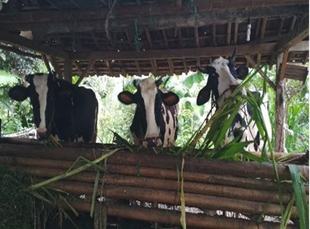Efisiensi reproduksi pada sapi perah yang teridentifikasi Bakteri non spesifik dalam saluran reproduksi
Downloads
Albarran-Portillo B, Pollott GE. 2008. Genetic
parameter devided from using a biological
model of lactation on records of
commercial dairy cows. J Dairy Sci. 91:
-48.
Anggraeni A. 2012. Indeks reproduksi sebagai
faktor penentu efisiensi reproduksi sapi
perah: Fokus kajian pada sapi perah Bos
Taurus. Pusat Penelitian Pengembangan
Peternakan. Bogor.
Ata A, Türütoğlu H, Kale M, Gülay MS,
Pehlivanoğlu F. Microbial flora of normal
and abnormal cervical mucous discharge
associated with reproductive performance
of cows and heifers in estrus. Asian-Aust
J Anim Sci. 23:1007-12.
Atabany A, Purwanto BP, Toharmat T,
Anggraeni A. 2011. Hubungan masa
kosong dengan produktivitas pada sapi
perah Friesian Holstein di Baturraden,
Indonesia. Media Peternakan. Jawa Barat
: 77-82.
Cunningham MW. 2000. Phatogenesis of
Group A Streptococoal Infection, Clin
Microbiol Rev. 13: 470- 511.
Dewi AK. 2013. Isolasi, Identifikasi dan Uji
Sensitivitas Staphylococcus aureus
terhadap Amoxicillin dari Sampel Susu
Kambing Peranakan Ettawa (PE) Penderita
Mastitis Di Wilayah Girimulyo,
Kulonprogo, Yogyakarta. J Sain Veteriner
: 138-50.
Fanani S, Subagyo YBP, Lutojo. 2013. Kinerja
Reproduksi Sapi Perah Peranakan Friesian
Holstein (PFH) di Kecamatan Pudak,
Kabupaten Ponorogo. Trop Anim Husb. 2:
-7.
Febrianthoro F, Hartono M, Suharyati S. 2015.
Faktor-faktor yang mempengaruhi
conception rate pada sapi Bali di
Kabupaten Pringsewu. J Ilmu Peternakan
Terpadu 3: 239-44.
Gani MO, Amin MM, Alam MGS, Kayesh
MEH, Karim MR, Samad MA, Islam M.
Bacterial flora associated with repeat
breeding and uterine infections in dairy
cows. Bangl J Vet Med. 6: 79– 86.
Gumelar AP, Aryanto R. 2011. Bobot Badan
dan Ukuran Tubuh SapiPerah Betina Fries
Holland di Wilayah Kerja Koperasi
Peternak Garut Selatan. Buana Sains 2:
-70.
Hafez ESE, Hafez B. 2010. Reproductive
Cycles. Dalam: Hafez B, Hafez ESE (Ed).
Reproduction in Farm Animals. 7th ed.
Lippincott William & Wilkins. A Wolter
Kluwer Company. 55-67.
Córdova-Izquierdo A, Xolalpa Campos VM,
Gustavo RuizLang C, Saltijeral Oaxaca
JA, Cortés Suárez S, Córdova-Jiménez
CA, Córdova-Jiménez MS, Peña Betancurt
SD, Guerra Liera JE. 2008. Effects of the
Offspring's Sex on Open Days in Dairy
Cattle. J Anim Vet Adv. 7: 1329-31.
Juhani T. 2009. Fixed-time Artifical
Insemination in Beef Cattle. J Acta Vet
Scand. 51: 48-53.
Madyawati SP, Srianto P, Tyasningsih W,
Sudrajad K, Lukitari AT, Safitri E. 2019.
Screening the Reproductive Tract of Dairy
Cattle for Pathogenic Micros. Indian Vet J.
: 12-5.
Niazi AAK, Aleem M. 2003. Comparative
Studies on the Reproductive Efficiency of
Imported and Local Born Friesian Cows in
Pakistan. J Biol Sci. 3: 388-395.
Nuryadi, Widyaningsih S. 2011. Penampilan
Reproduksi Sapi Peranakan Ongole dan
Peranakan Limousin di Kabupaten
Malang. J Ternak Tropika 12: 76-81.
Rahayu WP. 2003. Klasifikasi Bahan Pangan
dan Resiko Keamanannya. PT. Gramedia
Pustaka Utama. Jakarta.
Ratnasari R, Chusniati S. 2000. Explorasi
Bakteri dari Uterus Sapi Infertil di
Kotamadya Surabaya. Media Kedokteran
Hewan 1: 1-4.
Rosikh A, Aria A, Qomaruddin M. 2015.
Analisis Kawin Alami dengan Inseminasi
Buatan di Kecamatan Dukun Kabupaten
Gresik. J Ternak 6: 13-7.
Rusadi RP, Hartono M, Siswanto. 2015.
Service per conception pada sapi perah
laktasi di balai besar pembibitan ternak
unggul dan hijauan pakan ternak (BBPTUHPT) Baturaden Purwokerto Jawa Tengah.
J Ilmiah Peternakan Terpadu 3: 29-37.
Sheldon IM, Bushnell M, Montgomery J,
Rycroft AN. 2004. Minimum inhibitory
concentrations of some antimicrobial drugs
against bacteria causing uterine infections
in cattle. Vet Rec. 155: 383-7.
Sudrajad K, Madyawati SP, Tyasningsih W,
Rimayanti, Srianto P, Widodo OS. 2018.
Bacterial Isolates from Cervical Mucus of
Dairy Cattle at Follicular and Luteal
Phase. Phillip J Vet Med. 55: 121-6.
Syafruddin S, Rusli R, Hamdan H, Roslizawaty
R, Rianto S, Hudaya S. 2012. Akurasi
Metode Observasi Tidak Kembali Birahi
(Non Return to Estrus) dan
Ultrasonography (USG) untuk Diagnosis
Kebuntingan Kambing Peranakan Ettawah.
J Kedokteran Hewan 6: 87-91.
Winn W, Allen S, Janda W, Koneman E,
Procop G, Schreckenberger P, Woods G.
Color Atlas and Textbook of
Diagnostic Microbiology. 6th Ed.
Lippincott Williams & Wilkins.
Philadelphia. 114-5.
Ovozoa by Unair is licensed under a Creative Commons Attribution-ShareAlike 4.0 International License.
1. The journal allows the author to hold the copyright of the article without restrictions.
2. The journal allows the author(s) to retain publishing rights without restrictions
3. The legal formal aspect of journal publication accessibility refers to Creative Commons Attribution Share-Alike (CC BY-SA).
4. The Creative Commons Attribution Share-Alike (CC BY-SA) license allows re-distribution and re-use of a licensed work on the conditions that the creator is appropriately credited and that any derivative work is made available under "the same, similar or a compatible license”. Other than the conditions mentioned above, the editorial board is not responsible for copyright violation.




































